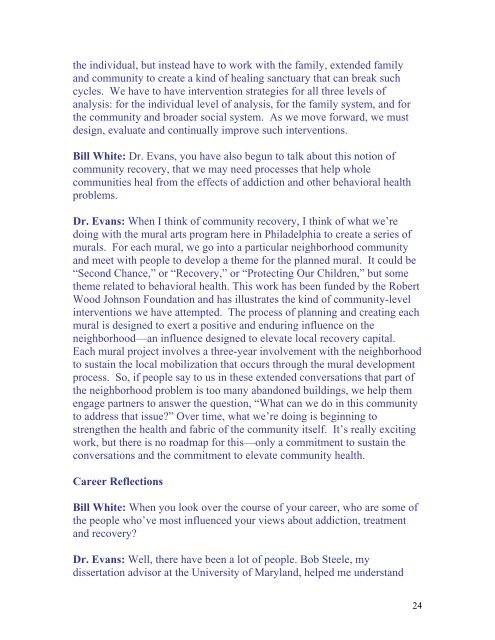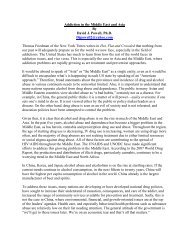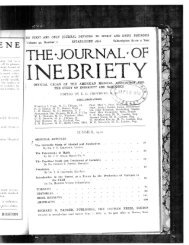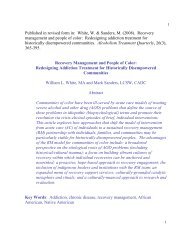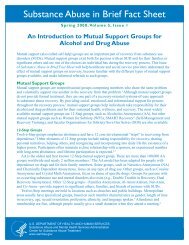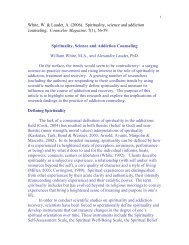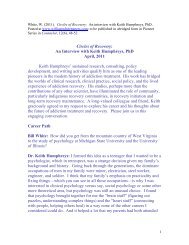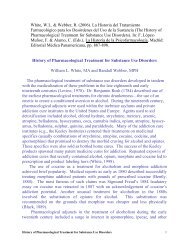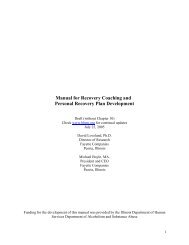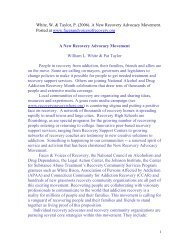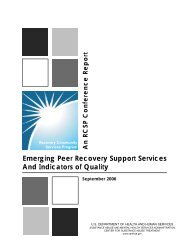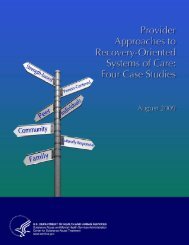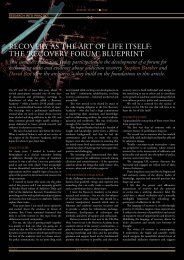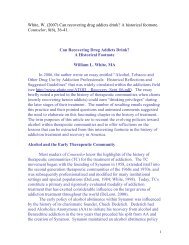An Interview with Arthur C. Evans, Jr., PhD Dr. Arthu - William L. White
An Interview with Arthur C. Evans, Jr., PhD Dr. Arthu - William L. White
An Interview with Arthur C. Evans, Jr., PhD Dr. Arthu - William L. White
- No tags were found...
Create successful ePaper yourself
Turn your PDF publications into a flip-book with our unique Google optimized e-Paper software.
the individual, but instead have to work <strong>with</strong> the family, extended familyand community to create a kind of healing sanctuary that can break suchcycles. We have to have intervention strategies for all three levels ofanalysis: for the individual level of analysis, for the family system, and forthe community and broader social system. As we move forward, we mustdesign, evaluate and continually improve such interventions.Bill <strong>White</strong>: <strong>Dr</strong>. <strong>Evans</strong>, you have also begun to talk about this notion ofcommunity recovery, that we may need processes that help wholecommunities heal from the effects of addiction and other behavioral healthproblems.<strong>Dr</strong>. <strong>Evans</strong>: When I think of community recovery, I think of what we’redoing <strong>with</strong> the mural arts program here in Philadelphia to create a series ofmurals. For each mural, we go into a particular neighborhood communityand meet <strong>with</strong> people to develop a theme for the planned mural. It could be“Second Chance,” or “Recovery,” or “Protecting Our Children,” but sometheme related to behavioral health. This work has been funded by the RobertWood Johnson Foundation and has illustrates the kind of community-levelinterventions we have attempted. The process of planning and creating eachmural is designed to exert a positive and enduring influence on theneighborhood—an influence designed to elevate local recovery capital.Each mural project involves a three-year involvement <strong>with</strong> the neighborhoodto sustain the local mobilization that occurs through the mural developmentprocess. So, if people say to us in these extended conversations that part ofthe neighborhood problem is too many abandoned buildings, we help themengage partners to answer the question, “What can we do in this communityto address that issue?” Over time, what we’re doing is beginning tostrengthen the health and fabric of the community itself. It’s really excitingwork, but there is no roadmap for this—only a commitment to sustain theconversations and the commitment to elevate community health.Career ReflectionsBill <strong>White</strong>: When you look over the course of your career, who are some ofthe people who’ve most influenced your views about addiction, treatmentand recovery?<strong>Dr</strong>. <strong>Evans</strong>: Well, there have been a lot of people. Bob Steele, mydissertation advisor at the University of Maryland, helped me understand24


